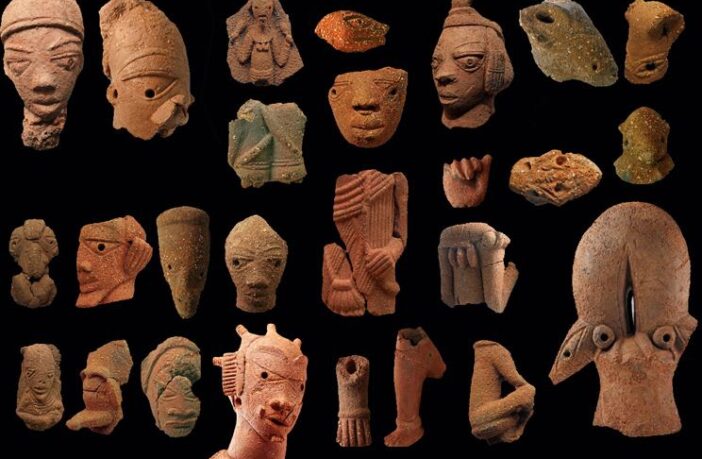I do not classify myself as an historian but I am currently obsessed with the past of the Nok Culture. Making me envision what life then was like. Stay with me, as we go through the loops of the settlements of the ancient Nok Culture.
Ancient Nok Farming
Similar to the peoples of the Chad Basin and Kintampo culture, the people of the Nok culture were said to have employed a mixed cropping method of cultivating cowpeas and pearl millet as well as utilized oleaginous fruits. At Pangwari, pearl millet was domesticated and cultivated, cowpeas were cultivated, and various forms of vegetation (e.g., Caesalpinioideae, Canarium schweinfurthii, Combretaceae, Phyllanthaceae, Vitex) were utilized. Hunting as discovered by the archaeologists, was another subsistence pattern followed by the Nok people.
Nok peoples may have migrated into the central region of Nigeria and brought into the area the agricultural knowledge of cultivating tamed pearl millet between 1500 BCE and 900 BCE. This is because, at almost all Nok sites, there are charred plant remains consisting of firewood and plant material for cooking. Remains of pearl millet, one of Africa’s oldest grain crops, are commonly found. Pearl millet is highly productive and resistant to adverse growing conditions, including drought. Cowpeas, valued for their high protein content, are also found at some sites. So far, pearl millet and cowpeas are the only crops known to have been cultivated by the Nok people. It is unclear whether they ate or farmed tubers of any kind. The numerous grinding stones found at Nok sites suggest that the grains were ground into flour and made into a type of porridge.
Hard pits from wild fruits have been found at many Nok sites. At some sites, fruit and seeds of other wild plants such as grasses and legumes were discovered. Overall there is not a huge selection of plant remains, but this could simply mean they were not preserved.
Ancient Nok Trees
The Nok people probably used an agroforestry system, combining cultivated crops with useful trees on the same plot of land. These plots are ecologically sustainable and inter-cropping of trees and several cultivated plant species were common from the savannas to the rain forest, with the origins of the practice going back to the first millennium BC, right at the time of the Nok culture. Most West African trees are not domesticated but are part of the wild vegetation which is left after farmers clear their fields of their crops. Because they are left to grow they multiply naturally without needing to be planted. Trees can produce food, medicine and animal feed.
Ancient Nok Animals
Unfortunately, due to the acidic soil, no animal bones from the Nok culture have been preserved, leaving no direct evidence of what species they might have domesticated (or hunted). The only evidence for animals during the Nok culture period is the depictions of animals as figurines or terracotta sculptures.
Ancient Nok Food
As of 3500 years ago, Nok agriculturalists gathered and utilized bee products (e.g., gathered honey in pottery). The honey may have been utilized by Nok agriculturalists to add to West African cuisines. As evidenced by remnants of beeswax and fats from animals on ceramics, the pottery may have been utilized to store meat, along with honey utilized for preservation purposes.
Ancient Nok Looting and repatriation
Since the 1970s, Nok terracotta figures have been heavily looted. Even larger-scale looting commenced in the Nok cultural area in 1994, and by 1995 two main local traders emerged. Each of the main traders could employ approximately 1,000 diggers to unearth terracottas every day. Although the majority of the terracottas were fragmented, some were intact and sellable. Because of this, hundreds of Nok Culture sites have been illegally dug in search of these terracotta sculptures. Valuable information about the Nok Culture is lost when these objects are taken from out of the ground and removed from their archaeological contexts.
In 1979, Nigeria’s National Commission of Museums and Monuments Decree established the National Commission for Museums and Monuments (NCMM), which is used to manage Nigeria’s cultural heritage. NCMM Decree number 77 made it illegal for anyone other than authorized personnel to buy or sell antiquities within Nigeria or export an antiquity without a permit from the NCMM. Towards the end of the 1990s the federal government of Nigeria implemented the NCMM, which initiated a series of actions to work out strategies for combating the problems of looting and to map out a plan of action. The general consensus was that laws governing antiquities and penalties for offenders needed to be strictly enforced and that all archaeological sites should be monitored. The NCMM also recommended more aggressive public enlightenment campaigns as well as a series of sensitization programs across the nation. These programs are considered a success in terms of increased awareness by law enforcement agents, as well as the Nigerian customs authorities and Interpol.
However, not all of the recommendations were implemented, because the Nigerian government did not have the resources to face the large scale of some of the challenges. For example, the government did not have the resources to place monitors at all archaeological sites, and terracotta figures still slip through Nigeria’s borders.
Today, the terracotta sculptures are very highly sought after on the international art market, and so artifacts continue to be dug up without documentation of the contexts in which they were buried. A lack of extensive archaeological study has also severely limited our understanding of the Nok cultures. A joint research project with Goethe University and the National Commission for Museums and Monuments conducted since 2005 showed that more than 90% of Nok Culture sites known in the research area have been illegally looted. Art historical studies carried out shows that over 1,000 Nok terracotta sculptures have been illegally excavated and smuggled into Europe, the USA, Japan, and elsewhere. In February 2013, Daily Trust reported that the Nigerian Federal Ministry of Information and National Orientation repossessed five Nok statuettes looted by a French thief in August 2010. The pieces had been seized by French customs agents and were repatriated following a Nigerian Government Directive. What further complicates the problem are the many workshops which fake Nok sculptures and then put them on the market as authentic.
Ancient Nok Descendants
As each share cultural and artistic similarity with the Nok culture found in Nok, Sokoto, and Katsina, the Niger-Congo-speaking Yoruba, Jukun, or Dakakari peoples may be descendants of the Nok peoples. Based on stylistic similarities with the Nok terracottas, the bronze figurines of the Yoruba kingdom of Ife and the Bini kingdom of Benin may also be continuations of the traditions of the earlier Nok culture.
“One of the things that I love to do is travel around the world and look at archaeological sites. Because archaeology gives us an opportunity to study past civilizations, and see where they succeeded and where they failed. Use science to, you know, work backwards and say, ‘Well, really, what were they thinking?’
-Nathan Myhrvold
PC: National Geographic Society
SOURCES:
• Breunig, Peter; Rupp, Nicole. “An Outline of Recent Studies on the Nigerian Nok Culture” (PDF). Brill. Journal of African Archaeology.
• Breunig, Peter. “Exploring the Nok Culture” (PDF). Goethe University, Institute for Archaeological Sciences, African Archaeology and Archaeobotany, Frankfurt/Main, Germany.
• Franke, Gabriele; et al. “Pits, pots and plants at Pangwari — Deciphering the nature of a Nok Culture site”. Taylor & Francis. Azania: Archaeological Research in Africa.
• Männel, Tanja M.; Breunig, Peter. “The Nok Terracotta Sculptures of Pangwari”. Brill. Journal of African Archaeology.





